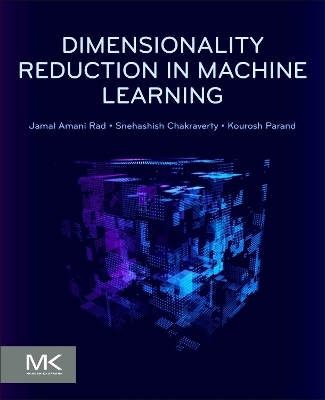
Dimensionality Reduction in Machine Learning
Morgan Kaufmann Publishers In (Verlag)
978-0-443-32818-3 (ISBN)
- Noch nicht erschienen (ca. April 2025)
- Versandkostenfrei innerhalb Deutschlands
- Auch auf Rechnung
- Verfügbarkeit in der Filiale vor Ort prüfen
- Artikel merken
Finally, Part Four covers Deep Learning Methods for Dimension Reduction, with chapters on Feature Extraction and Deep Learning, Autoencoders, and Dimensionality reduction in deep learning through group actions. With this stepwise structure and the applied code examples, readers become able to apply dimension reduction algorithms to different types of data, including tabular, text, and image data.
Dr. Jamal Amani Rad currently works in Choice Modelling Centre and Institute for Transport Studies, University of Leeds, Leeds LS2 9JT, UK He obtained his PhD in Mathematics at the Department of Mathematics at University of Shahid Beheshti. His research interests include modelling, numerics, and analysis of partial differential equations by using meshless methods, with an emphasis on applications from finance. Dr. Snehashish Chakraverty has over thirty years of experience as a teacher and researcher. Currently, he is a Senior Professor in the Department of Mathematics (Applied Mathematics Group) at the National Institute of Technology Rourkela, Odisha, India. He has a Ph.D. from IIT Roorkee in Computer Science. Thereafter he did his post-doctoral research at Institute of Sound and Vibration Research (ISVR), University of Southampton, U.K. and at the Faculty of Engineering and Computer Science, Concordia University, Canada. He was also a visiting professor at Concordia and McGill Universities, Canada, and visiting professor at the University of Johannesburg, South Africa. He has authored/co-authored 14 books, published 315 research papers in journals and conferences, and has four more books in development. Dr. Chakraverty is on the Editorial Boards of various International Journals, Book Series and Conferences. Dr. Chakraverty is the Chief Editor of the International Journal of Fuzzy Computation and Modelling (IJFCM), Associate Editor of Computational Methods in Structural Engineering, Frontiers in Built Environment, and is the Guest Editor for several other journals. He was the President of the Section of Mathematical sciences (including Statistics) of the Indian Science Congress. His present research area includes Differential Equations (Ordinary, Partial and Fractional), Soft Computing and Machine Intelligence (Artificial Neural Network, Fuzzy and Interval Computations), Numerical Analysis, Mathematical Modeling, Uncertainty Modelling, Vibration and Inverse Vibration Problems. Dr. Kourosh Parand is a Professor in International Business University, Toronto, Canada . His main research field is Scientific Computing, Spectral Methods, Meshless methods, Ordinary Differential Equations (ODEs), Partial Differential Equations(PDEs) and Computational Neuroscience Modeling.
Part 1: Introduction to Machine Learning and Data Life Cycle
1. Basics of Machine Learning
2. Essential Mathematics for Machine Learning
3. Feature Selection Methods
Part 2: Linear Methods for Dimension Reduction
4. Principal Component Analysis
5. Linear Discriminant Analysis
Part 3: Non-Linear Methods for Dimension Reduction
6. Linear Local Embedding
7. Multi-dimensional Scaling
8. t-distributed Stochastic Neighbor Embedding
Part 4: Deep Learning Methods for Dimension Reduction
9. Feature Extraction and Deep Learning
10. Autoencoders
11. Dimensionality reduction in deep learning through group actions
| Erscheint lt. Verlag | 1.4.2025 |
|---|---|
| Verlagsort | San Francisco |
| Sprache | englisch |
| Maße | 191 x 235 mm |
| Gewicht | 450 g |
| Themenwelt | Geisteswissenschaften ► Sprach- / Literaturwissenschaft ► Sprachwissenschaft |
| Informatik ► Theorie / Studium ► Künstliche Intelligenz / Robotik | |
| ISBN-10 | 0-443-32818-8 / 0443328188 |
| ISBN-13 | 978-0-443-32818-3 / 9780443328183 |
| Zustand | Neuware |
| Informationen gemäß Produktsicherheitsverordnung (GPSR) | |
| Haben Sie eine Frage zum Produkt? |
aus dem Bereich


